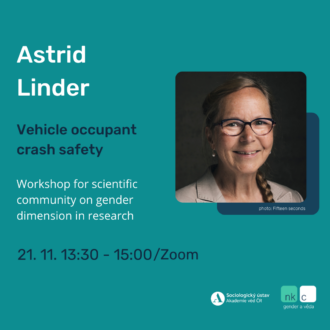
Astrid Linder: Vehicle occupant crash safety: Injury data, crash testing and the world’s first crash test dummy of an average female
When: 21. 11. 13:30 – 15:00
Where: Zoom
Registration: here till 19. 11.
We would like to kindly invite you to a webinar titled Vehicle occupant crash safety: Injury data, crash testing and the world’s first crash test dummy of an average female with Professor Astrid Linder, which is part of educational activities of Centre for Gender and Science focusing on gender dimension in research.
On our roads 1.35 million people lose their lives yearly and, according to the World Health Organization (WHO), in the order of 20-50 million are injured – some of which become permanently disabled. Real-world injury data shows that cars provide different levels of protection for women compared to men in the event of a crash. The largest difference has been shown for soft tissue neck injuries, the so-called whiplash injuries, which are injuries that can cause lifelong disabilities. On average, females have double the risk of sustaining these injuries compared to males.
When we assess the safety of the occupants in a vehicle the average male is the norm. In crash testing the occupant is represented by a crash test dummy and so far, no crash test dummy of an average female is required to be used in any testing nor available from any dummy manufacturer. The law in Europe, the Treaty of the Union, requires that women and men shall be addressed equally, yet the global regulation (UNCEC) that is used in Europe requires a model of the average male to be used as the driver in all tests, full stop. The first crash test dummy of an average male, as we know him today with some updates, was designed over 50 years ago. And we have just very recently started designing the model representing the average female.
The lecture will contain details of what is described above and a description of real-world data showing different levels of crash protection for females and males. I will also present the background and development of the world’s first crash test dummy of an average female, the Seat Evaluation Tool (SET) 50F, and the equivalent average male, the SET 50M. Furthermore, the validation of the models is described and recent tests with different car seats are used as an illustration of what can be identified from crash tests when both a model of the female and male part of the population is used. In addition, the recent development of virtual models for the assessment of occupant protection will be described and discussed.
Bio
Astrid Linder is a Professor of Traffic Safety at Swedish National Road and Transport Research Institute, VTI, and an Adjunct Professor of Injury Prevention at Chalmers University and an Adjunct Associate Professor at Monash University Accident Research Centre, Melbourne, Australia. She received her PhD in traffic safety from Chalmers from where she also has a MSc in Engineering Physics. Traffic safety, models of the human in crash testing, injury prevention and crash related countermeasures are main fields of her research in which she has extensively published and presented around the world.
Prof Linder coordinated the EU-funded project ADSEAT where the world’s first virtual dummy model of an average female for rear impact, EvaRID, was developed. She also coordinated the EU-funded project VIRTUAL in which the world’s first physical dummy model based on the average female, the Seat Evaluation Tool (SET 50F) together with the average male SET 50M, were developed as well as the open-source human body models VIVA+ 50F and 50M for road user safety assessment.
She has been appointed “Equality Star of the Year” by the Swedish Network for Equality in the Transport Sector (2020), presented with the US Government Safety Engineering Excellence (2015), the Volvo Research and Educational Foundations Håkan Frisinger awards (2015), the EU Champions of Transport Research Road (2014) and the EU Champions of Transport Research Overall Winner Transport (2014).
